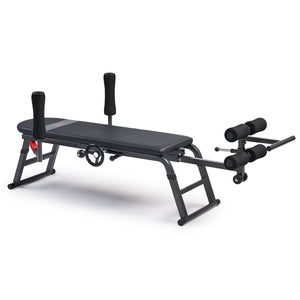Neck pain is an all-too-common issue that can disrupt your daily life, affecting everything from your work productivity to your ability to enjoy simple activities. Whether it’s a result of poor posture, long hours at a desk, or the stress of everyday life, the discomfort can range from a dull ache to sharp, debilitating pain.
But the good news is that relief is within reach. While there is no quick fix for a stiff neck, gentle movement, stretching, and exercise can all help gradually reduce your neck pain so you can return to all your favorite daily activities, pain free. Read on to learn about what often causes neck pain so you can avoid it, and what you can do to for relief if you’re suffering from that pesky pain in the neck!
What Causes Neck Pain?
Neck pain can arise for various reasons, but we can separate these reasons into two main categories: acute and chronic.
Acute neck pain refers to pain that is linked to a specific incident, like a car-accident or a fall. This incident results in an injury to the neck, which in turn leads to discomfort and pain that can significantly impact daily activities and overall quality of life. This will most often require a gentler approach and intervention from your doctor and/or physical therapist.
Chronic neck pain refers to pain that is ongoing and is usually not linked to one specific incident. Things like improper posture, stress, frequent desk work, or sleeping position can all be contributing factors. This type of pain is typically caused by an imbalance of muscular strength and a deficiency in neck and shoulder mobility. A consistent strength and mobility routine can help address these symptoms.
Effective Ways to Find Relief
When neck pain does arise, there are several ways to comprehensively approach finding relief. Here’s how.
Be Mindful of Posture
Be sure to check in with your posture throughout the day. If you are often sitting at a desk, it’s easy to slip into poor posture, which can lead to neck pain over time. One effective strategy is to adjust your workspace so that it best fits your body. Ensure your monitor is at eye level and your chair provides good support for your lower back. Keeping your feet flat on the floor and your knees at a right angle can also make a significant difference.
Additionally, remember to take regular breaks. Standing up, stretching, and moving around every 30 to 60 minutes helps relieve tension and improves circulation. When using your phone or tablet, practice ergonomic techniques by holding the device at eye level instead of looking down, which reduces strain on your neck. Being mindful of your head position is crucial too; try to keep your ears aligned with your shoulders to avoid jutting your head forward or slumping your shoulders.
By being conscious of your posture and making these small adjustments, you can significantly reduce the risk of neck pain and promote overall spinal health. Remember, a little awareness goes a long way!
Prioritize Stress Management
Managing stress is essential for overall well-being and can help significantly reduce neck pain. When under stress, your body often responds with muscle tension, particularly in the neck and shoulders. To mitigate this, consider incorporating relaxation techniques into your daily routine.
One effective method is mindfulness meditation. Taking just a few minutes each day to focus on your breath can help calm your mind and release tension in your body. Guided meditation, like the ones offered on the SunnyFit® app can be a game-changer, too.
Exercise
Incorporating specific exercises into your routine can help alleviate neck pain and improve overall neck health. Here are some effective exercises to consider:
Upper Trap & Levator Stretch

To target the upper trapezius and levator scapulae muscles, sit or stand comfortably. Slowly tilt your head to one side, bringing your ear toward your shoulder. For a deeper stretch, use your hand to gently pull your head closer to your shoulder. Hold for 15-30 seconds, then switch sides. Next, point your nose towards your armpit and place gentle pressure on the back of your head with your hand. Hold for 15-30 seconds, then switch sides. This stretch helps release tension and improve flexibility in the neck.
Half Circles
This exercise helps increase mobility in the neck. While seated or standing, gently drop your chin to your chest and then slowly roll your head in a half-circle to one side, bringing your ear toward your shoulder. Continue the motion until you reach the opposite shoulder, then reverse the direction. Repeat for 5-10 cycles, moving slowly and with control.
Neck Retraction

Neck retraction strengthens the muscles that support good posture. Sit or stand with your back straight. Gently tuck your chin in towards your neck, drawing your head back while keeping your eyes forward. Hold this position for 5 seconds, then relax. Repeat 10 times. This exercise helps counteract the forward head posture often caused by prolonged screen time.
I’s, Y’s, T’s
This series of exercises targets the upper back and shoulder muscles, which are crucial for neck stability. Lie face down on a flat surface or use a stability ball. Extend your arms straight in front of you for the "I" position, lifting them slightly off the ground. For the "Y" position, raise your arms diagonally at a 45-degree angle. Finally, move your arms out to the sides for the "T" position. Hold each position for 5-10 seconds, repeating the sequence 5 times. These exercises strengthen the muscles that support proper posture and reduce strain on the neck.
Incorporating these exercises into your daily routine can help alleviate neck pain, improve mobility, and promote better posture. Always listen to your body and consult with a healthcare professional if you experience any discomfort or have underlying health conditions.
A Mindful and Well-Rounded Approach
Addressing neck pain requires a comprehensive strategy that combines mindfulness, posture awareness, stress management, and targeted exercises. By being conscious of your daily habits and making intentional changes, you can significantly reduce discomfort and improve your overall well-being. Regularly checking your posture, practicing relaxation techniques, and incorporating specific neck exercises into your routine can create a strong foundation for lasting relief.




























Add Your Name & Email
Please enter your name and email to continue.We won’t display your email publicly.